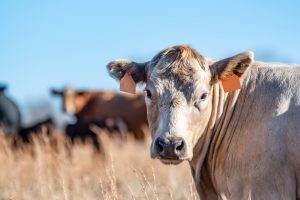R.F.D. News & Views
By Tim Alexander For Chronicle Media — July 12, 2025
A ban on importing Mexican cattle due to the threat of the New World Screwworm has driven up beef prices.
Shoppers, have you noticed how much ground beef has increased in price in recent days? Read on for a breakdown of the drivers behind the price spike, along with a look at soil conditions around the state…
Beef prices spike on news of Mexican livestock ban
WASHINGTON, D.C. – A trip to my neighborhood supermarket on Saturday revealed that tubed ground beef had soared to more than $6 per pound, even when bought in 3- or 5-pound tubes.
In some areas, ground beef has been reported selling for as much as $10 per pound.
This is a direct market reaction to the U.S. Department of Agriculture’s recent ban on imports of Mexican cattle due to the threat of the New World Screwworm. On July 9, Mexico’s National Service of Agro-Alimentary Health, Safety, and Quality reported a new case of NWS on the eastern side of the country, just 370 miles south of the U.S.-Mexico border.
The new case “raises significant concern about the previously reported information shared by Mexican officials and severely compromises the outlined port reopening schedule of five ports from July 7-September 15,” according to a USDA news release. “Therefore, in order to protect American livestock and our nation’s food supply, (USDA) Secretary (Brooke) Rollins has ordered the closure of livestock trade through southern ports of entry effective immediately.”
In June, Rollins launched a plan to combat New World Screwworm that emphasized protecting the border through port closures, increasing screwworm eradication efforts in Mexico and increasing unspecified readiness efforts. USDA also announced the groundbreaking of a sterile fly dispersal facility in South Texas, which will provide “a critical contingency capability to disperse sterile flies should a NWS detection be made in the southern United States. Simultaneously, USDA is moving forward with the design process to build a domestic sterile fly production facility to ensure it has the resources to push NWS back.”
CBS News reported that in combination with shrinking cattle herds (the number of U.S. cattle in 2025 is estimated at 27.8 million, the lowest since the 1960s), the ban on Mexican beef due to the screwworm threat is responsible for the spike in retail prices, which are now the highest since the Department of Labor started tracking beef prices in the 1980s. This includes a 45-percent hike in the price of ground beef over the past 10 years.
Soil moisture lacking before weekend rains
URBANA — University of Illinois crop experts reported moderately dry to near-normal soil conditions across the state last week, prior to much-welcomed rainfall that blanketed much of Illinois on Friday evening into early Saturday.
Steve Brand, U of I Extension commercial agriculture specialist for Grundy and DeKalb counties, said soil conditions there were mildly dry, meaning soil is drier than normal.
“Another dry week for northern Illinois, with a few isolated storms occurring further west or in Chicago. We have slid back into a predominantly D1 drought, with large areas of Kane and Will County entering into a D2 drought. Corn and soybeans have started to grow out of the early season stunting, but both crops are looking likely to be short overall this season,” said Brand, adding,“Plant growth may have slowed.”
Soil conditions were also mildly dry in Logan County, according to Reagan Tibbs, Extension crop educator.
“Rainfall has also been variable across the area over the last week,” she said. “Some parts of the county received around an inch of rain, while some received a half-inch or less.”
Doug Gucker, local food systems and small farms educator for Dewitt, Macon, and Piatt County Extension, reported “mildly dry” soil conditions.
“Currently, the corn and soybean crops are looking good. Some corn in the drier areas has fired on the lower leaves,” Gucker said. “The past 14-day rainfall has been over 150 percent of normal in southern Macon and Piatt counties to less than 25 percent of normal through the balance of the three-county area.”
Talon Becker, Extension commercial ag specialist in Douglas County, reported soil conditions as near normal.
“With about 0.5-1.0″ of rain and some cooler temperatures this past week, corn and soybean crops in Douglas County are looking healthy during this vital flowering period,” he noted. (Illinois Extension. & Illinois Crop Update – July 11, 2025.)
Livestock vehicle rollover training offered
SPRINGFIELD – The Illinois Pork Producers Association and Illinois Beef Association are sponsoring emergency livestock vehicle rollover response training classes for first responders, haulers, farmers and others during three upcoming sessions. Classroom content on livestock behavior, responder safety, scene management and handling priorities will be addressed.
Hands-on training will be provided through the use of a livestock trailer to simulate a rollover and response. In addition, interactive discussions with trainers experienced in animal welfare and emergency response will be offered.
Training location information
Each session starts at 6 p.m., with doors opening at 5:30 p.m.
- July 22: Illinois Fire Service Institute – LRRC Auditorium – 11 Gerty Drive. Champaign
- July 23: NIU Barsema Alumni & Visitors Center – BAVC Board Room – 231 N. Annie Glidden Road, DeKalb
- July 24:: Black Hawk College East Campus – Building A- Room A-116 – 26230 Black Hawk Road, Galva
For information, contact Gage Marinelli at gage@ilpork.com or 217-638-3828.
Illinois Farm Fact:
Imports of Mexican cattle have averaged 3.2 percent of the U.S. calf crop for the past 25 years, ranging from 1.9 to 4.3 percent. (mexicanbeef.org)
Tim Alexander is a freelance writer.







